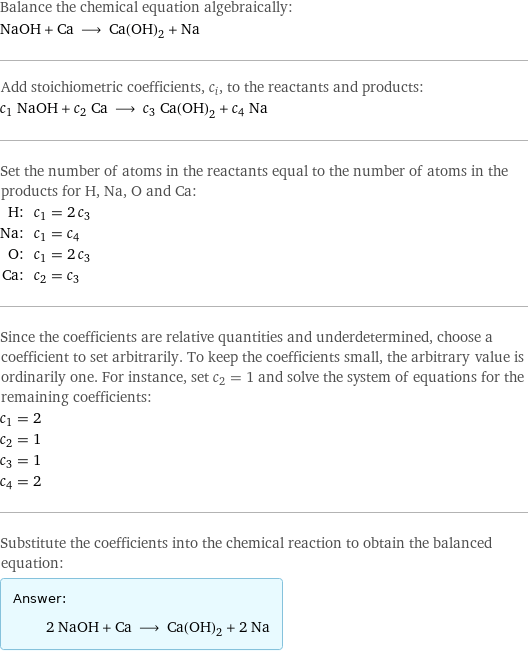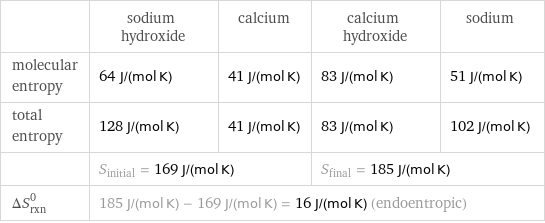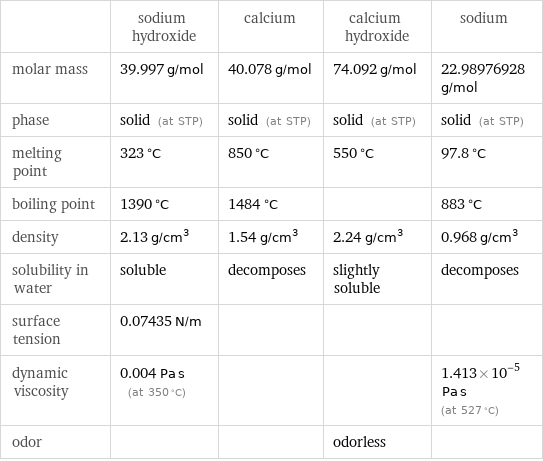Input interpretation

NaOH sodium hydroxide + Ca calcium ⟶ Ca(OH)_2 calcium hydroxide + Na sodium
Balanced equation

Balance the chemical equation algebraically: NaOH + Ca ⟶ Ca(OH)_2 + Na Add stoichiometric coefficients, c_i, to the reactants and products: c_1 NaOH + c_2 Ca ⟶ c_3 Ca(OH)_2 + c_4 Na Set the number of atoms in the reactants equal to the number of atoms in the products for H, Na, O and Ca: H: | c_1 = 2 c_3 Na: | c_1 = c_4 O: | c_1 = 2 c_3 Ca: | c_2 = c_3 Since the coefficients are relative quantities and underdetermined, choose a coefficient to set arbitrarily. To keep the coefficients small, the arbitrary value is ordinarily one. For instance, set c_2 = 1 and solve the system of equations for the remaining coefficients: c_1 = 2 c_2 = 1 c_3 = 1 c_4 = 2 Substitute the coefficients into the chemical reaction to obtain the balanced equation: Answer: | | 2 NaOH + Ca ⟶ Ca(OH)_2 + 2 Na
Structures

+ ⟶ +
Names

sodium hydroxide + calcium ⟶ calcium hydroxide + sodium
Reaction thermodynamics
Enthalpy

| sodium hydroxide | calcium | calcium hydroxide | sodium molecular enthalpy | -425.8 kJ/mol | 0 kJ/mol | -985.2 kJ/mol | 0 kJ/mol total enthalpy | -851.6 kJ/mol | 0 kJ/mol | -985.2 kJ/mol | 0 kJ/mol | H_initial = -851.6 kJ/mol | | H_final = -985.2 kJ/mol | ΔH_rxn^0 | -985.2 kJ/mol - -851.6 kJ/mol = -133.6 kJ/mol (exothermic) | | |
Entropy

| sodium hydroxide | calcium | calcium hydroxide | sodium molecular entropy | 64 J/(mol K) | 41 J/(mol K) | 83 J/(mol K) | 51 J/(mol K) total entropy | 128 J/(mol K) | 41 J/(mol K) | 83 J/(mol K) | 102 J/(mol K) | S_initial = 169 J/(mol K) | | S_final = 185 J/(mol K) | ΔS_rxn^0 | 185 J/(mol K) - 169 J/(mol K) = 16 J/(mol K) (endoentropic) | | |
Equilibrium constant
![Construct the equilibrium constant, K, expression for: NaOH + Ca ⟶ Ca(OH)_2 + Na Plan: • Balance the chemical equation. • Determine the stoichiometric numbers. • Assemble the activity expression for each chemical species. • Use the activity expressions to build the equilibrium constant expression. Write the balanced chemical equation: 2 NaOH + Ca ⟶ Ca(OH)_2 + 2 Na Assign stoichiometric numbers, ν_i, using the stoichiometric coefficients, c_i, from the balanced chemical equation in the following manner: ν_i = -c_i for reactants and ν_i = c_i for products: chemical species | c_i | ν_i NaOH | 2 | -2 Ca | 1 | -1 Ca(OH)_2 | 1 | 1 Na | 2 | 2 Assemble the activity expressions accounting for the state of matter and ν_i: chemical species | c_i | ν_i | activity expression NaOH | 2 | -2 | ([NaOH])^(-2) Ca | 1 | -1 | ([Ca])^(-1) Ca(OH)_2 | 1 | 1 | [Ca(OH)2] Na | 2 | 2 | ([Na])^2 The equilibrium constant symbol in the concentration basis is: K_c Mulitply the activity expressions to arrive at the K_c expression: Answer: | | K_c = ([NaOH])^(-2) ([Ca])^(-1) [Ca(OH)2] ([Na])^2 = ([Ca(OH)2] ([Na])^2)/(([NaOH])^2 [Ca])](../image_source/9092f4733f9137c4293672a74032f8af.png)
Construct the equilibrium constant, K, expression for: NaOH + Ca ⟶ Ca(OH)_2 + Na Plan: • Balance the chemical equation. • Determine the stoichiometric numbers. • Assemble the activity expression for each chemical species. • Use the activity expressions to build the equilibrium constant expression. Write the balanced chemical equation: 2 NaOH + Ca ⟶ Ca(OH)_2 + 2 Na Assign stoichiometric numbers, ν_i, using the stoichiometric coefficients, c_i, from the balanced chemical equation in the following manner: ν_i = -c_i for reactants and ν_i = c_i for products: chemical species | c_i | ν_i NaOH | 2 | -2 Ca | 1 | -1 Ca(OH)_2 | 1 | 1 Na | 2 | 2 Assemble the activity expressions accounting for the state of matter and ν_i: chemical species | c_i | ν_i | activity expression NaOH | 2 | -2 | ([NaOH])^(-2) Ca | 1 | -1 | ([Ca])^(-1) Ca(OH)_2 | 1 | 1 | [Ca(OH)2] Na | 2 | 2 | ([Na])^2 The equilibrium constant symbol in the concentration basis is: K_c Mulitply the activity expressions to arrive at the K_c expression: Answer: | | K_c = ([NaOH])^(-2) ([Ca])^(-1) [Ca(OH)2] ([Na])^2 = ([Ca(OH)2] ([Na])^2)/(([NaOH])^2 [Ca])
Rate of reaction
![Construct the rate of reaction expression for: NaOH + Ca ⟶ Ca(OH)_2 + Na Plan: • Balance the chemical equation. • Determine the stoichiometric numbers. • Assemble the rate term for each chemical species. • Write the rate of reaction expression. Write the balanced chemical equation: 2 NaOH + Ca ⟶ Ca(OH)_2 + 2 Na Assign stoichiometric numbers, ν_i, using the stoichiometric coefficients, c_i, from the balanced chemical equation in the following manner: ν_i = -c_i for reactants and ν_i = c_i for products: chemical species | c_i | ν_i NaOH | 2 | -2 Ca | 1 | -1 Ca(OH)_2 | 1 | 1 Na | 2 | 2 The rate term for each chemical species, B_i, is 1/ν_i(Δ[B_i])/(Δt) where [B_i] is the amount concentration and t is time: chemical species | c_i | ν_i | rate term NaOH | 2 | -2 | -1/2 (Δ[NaOH])/(Δt) Ca | 1 | -1 | -(Δ[Ca])/(Δt) Ca(OH)_2 | 1 | 1 | (Δ[Ca(OH)2])/(Δt) Na | 2 | 2 | 1/2 (Δ[Na])/(Δt) (for infinitesimal rate of change, replace Δ with d) Set the rate terms equal to each other to arrive at the rate expression: Answer: | | rate = -1/2 (Δ[NaOH])/(Δt) = -(Δ[Ca])/(Δt) = (Δ[Ca(OH)2])/(Δt) = 1/2 (Δ[Na])/(Δt) (assuming constant volume and no accumulation of intermediates or side products)](../image_source/0860fdc06b8130c4a51cbceada9166ac.png)
Construct the rate of reaction expression for: NaOH + Ca ⟶ Ca(OH)_2 + Na Plan: • Balance the chemical equation. • Determine the stoichiometric numbers. • Assemble the rate term for each chemical species. • Write the rate of reaction expression. Write the balanced chemical equation: 2 NaOH + Ca ⟶ Ca(OH)_2 + 2 Na Assign stoichiometric numbers, ν_i, using the stoichiometric coefficients, c_i, from the balanced chemical equation in the following manner: ν_i = -c_i for reactants and ν_i = c_i for products: chemical species | c_i | ν_i NaOH | 2 | -2 Ca | 1 | -1 Ca(OH)_2 | 1 | 1 Na | 2 | 2 The rate term for each chemical species, B_i, is 1/ν_i(Δ[B_i])/(Δt) where [B_i] is the amount concentration and t is time: chemical species | c_i | ν_i | rate term NaOH | 2 | -2 | -1/2 (Δ[NaOH])/(Δt) Ca | 1 | -1 | -(Δ[Ca])/(Δt) Ca(OH)_2 | 1 | 1 | (Δ[Ca(OH)2])/(Δt) Na | 2 | 2 | 1/2 (Δ[Na])/(Δt) (for infinitesimal rate of change, replace Δ with d) Set the rate terms equal to each other to arrive at the rate expression: Answer: | | rate = -1/2 (Δ[NaOH])/(Δt) = -(Δ[Ca])/(Δt) = (Δ[Ca(OH)2])/(Δt) = 1/2 (Δ[Na])/(Δt) (assuming constant volume and no accumulation of intermediates or side products)
Chemical names and formulas

| sodium hydroxide | calcium | calcium hydroxide | sodium formula | NaOH | Ca | Ca(OH)_2 | Na Hill formula | HNaO | Ca | CaH_2O_2 | Na name | sodium hydroxide | calcium | calcium hydroxide | sodium IUPAC name | sodium hydroxide | calcium | calcium dihydroxide | sodium
Substance properties

| sodium hydroxide | calcium | calcium hydroxide | sodium molar mass | 39.997 g/mol | 40.078 g/mol | 74.092 g/mol | 22.98976928 g/mol phase | solid (at STP) | solid (at STP) | solid (at STP) | solid (at STP) melting point | 323 °C | 850 °C | 550 °C | 97.8 °C boiling point | 1390 °C | 1484 °C | | 883 °C density | 2.13 g/cm^3 | 1.54 g/cm^3 | 2.24 g/cm^3 | 0.968 g/cm^3 solubility in water | soluble | decomposes | slightly soluble | decomposes surface tension | 0.07435 N/m | | | dynamic viscosity | 0.004 Pa s (at 350 °C) | | | 1.413×10^-5 Pa s (at 527 °C) odor | | | odorless |
Units
